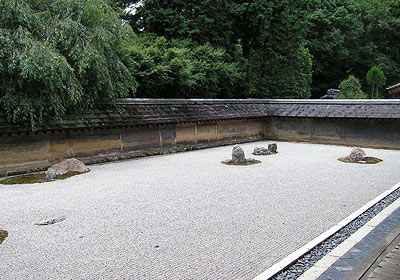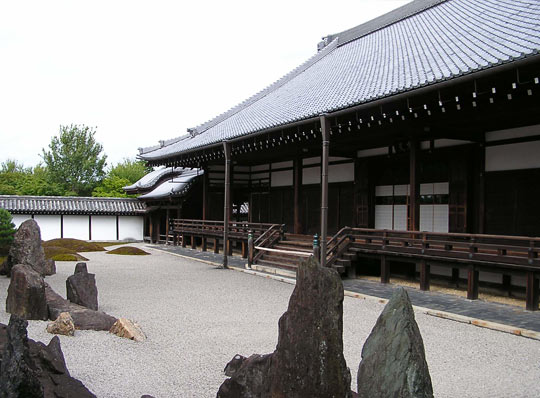| Lit.
dry landscape. A common type of garden which suggests mountains and water
using only stones, sand or gravel and, occasionally, plants. Water is symbolized
both by the arrangements of rock forms to create a dry waterfall *karetaki Íê and by patterns raked into sand to create a dry stream *karenagare ͬ. The word karesansui is found in the 11c garden manual *SAKUTEIKI ìëL and garden historians have designated Heian period rock arrangemants
as zenkishiki karesansui OúÍR
. Karesansui usually refers
to dry gardens of the Muromachi, Momoyama and Edo periods, although the
term kouki karesansui ãúÍR
has been created to distinguish this
later type. Because of their similarity to ink monochrome landscape painting suiboku sansuiga
nR
æ, particularly that of the Chinese Northern
Song dynasty, karesansui gardens are also called *suiboku
sansuigashiki teien
nR
æ®ë or *hokusou sansuigashiki teien kvR
æ®ë.
Like paintings, the gardens are meant to be viewed from a single, seated
perspective. In addition to the aesthetic similarities to Chinese painting,
the rocks in karesansui are often associated with Chinese mountains
such as Mt. Penglai (Jp; *Houraisan HR) or Mt. Lu (Jp; Rosan á¸R). Given the multiple Chinese associations of karesansui gardens, they are the preferred type of garden for Zen
T temples (Buddhism having arrived from China in the 7c) and the best examples
are found in the front or rear gardens of Zen abbots' residences *houjou ûä. Exemplary Muromachi period examples include the gardens at Daisen-in
åå@ in Daitokuji å¿ and at Ryouanji ´À. While Muromachi karesansui tend to use plants sparingly, early Edo period gardens of this type often
contrast an area of raked gravel with a section of moss and larger plants
along the rear wall. The gardens at the Houjou and Konchi-in àn@ at Nanzenji
ìT, and Shinjuan ^ìÁ and Oubai-in ©~@ at Daitokuji are good examples. The aesthetic consonance with abstract art largely accounts for the resurgence of karesansui gardens both in Japan and abroad in the 20c. A good example of a modern karesansui is Shigemori Mirei's dXOé (1896-1975) east garden at Toufukuji Houjou ûä. |




